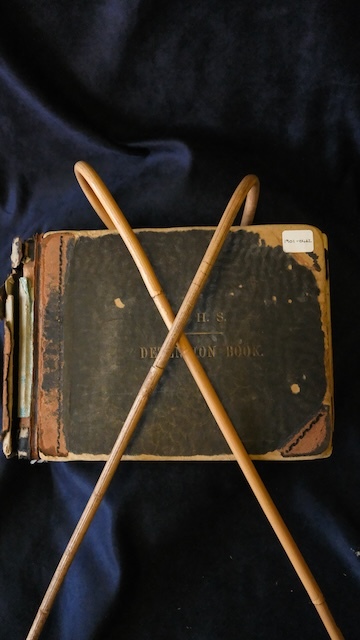- Home
- About Us
- Our History
Our History
Founded in 1513, Nottingham High School has a rich history full of amazing accomplishments and famous figures. Here is a brief snapshot of our 511 year history
1513
The School was founded as the "Free School" by Dame Agnes Mellers and held in St. Mary's Church in the Lace Market. The School's Foundation Charter was granted by King Henry VIII
1551
The School was given a building on the corner of Stoney Street and Barkergate.
1594
The second Charter was signed by Queen Elizabeth I.
1606
Former pupil Henry Garnett was executed for complicity in the Gunpowder Plot. He attended the School from 1564 -1566 and was the son of Headmaster Brian Garnett.
1626
Colonel John Hutchinson, MP and Roundhead in the Civil war, attended the School from 1626 - 1632. In 1649 as Governor of Nottingham he signed the death-warrant of King Charles I.
1822 - 1823
Thomas Hawksley attended the School, and later became one of the nineteenth century and a fellow of the Royal Society.
1838 - 1841
John Peake Knight attended the School. He went on to become the inventor of roadside traffic lights in 1868.
1861 - 1863
Sir Jesse Boot, the most successful retailer in the history of Nottingham, attended the School. He was responsible for transforming The Boots Company into a national retailer.
1868
The new School was built and opened in its current location on Arboretum Street. It changed its name from The Free Grammar School to Nottingham High School.
1869 - 1875
Early Notts County and England footballer Henry "Harry" Cursham attended the School.
1891 - 1907
Rev. Theodore Bayley Hardy VC was a Master at the School. Later, as Army Chaplain, he became one of the most decorated non-combatants of the First World War.
1898 - 1901
Winter D. H. Lawrence attended the School.
1900
The Cadet Corps, now known as the CCF, was formed.
1905
The Preparatory School was started, catering to pupils aged 8 to 11.
1907 - 1910
WW1 fighter pilot Albert Ball attended the School. At the time of his death in 1917 he was the UK's leading flying ace, and was posthumously awarded the Victoria Cross for his actions during his final tour of duty.
1909
The House system was founded, with each named after a significant benefactor of the School. Dame Agnes Mellers, Samuel Maples, Sir Thomas White and Frederick Cooper.
1914
The 34th Nottingham Scout Troop was founded, just 5 years after Scouting began.
1914 - 18
231 Old Nottinghamians were killed in the First World War, with 124 decorations including two Victoria Crosses.
1921
The War Memorial was unveiled at the front of the School, paid for by donations from the school community.
1931
Land was purchased at Valley Road for a Sports Ground Pavilion.
1932 - 1938
Rolf Noskwith attended the School. During the Second World War he worked under Alan Turing as a cryptographer at Bletchley Park.
1930's
The Old Gym and Player Hall were built, following a donation from the Tobacco Magnate John Player.
1939 - 1945
Over 600 Old Nottinghamians and Masters served in the Armed Forces in the Second World War, 88 losing their lives.
1949
The Schools was granted its full coat of arms with the three Merles of the Mellers family at its centre.
1951 - 1959
Kenneth Clarke attended the School. He later went on to become a Conservative politician, serving as Home Secretary, Chancellor of the Exchequer and Lord Chancellor.
1964 - 1965
The Founder Hall and swimming pool were built to commemorate the 450th Anniversary of the school.
1977 - 1978
Waverley Mount was purchased and the Preparatory School transformed into the new Junior School building.
1978 - 1985
Labour politician Ed Balls attended the School and later served as Shadow Home Secretary and Shadow Chancellor of the Exchequer.
1984
The Duke of Edinburgh visited the School to officially open the Simon Djanogly Science Building.
1986 - 1994
Aleem Maqbool, BBC Journalist and North American Correspondent who broke the story of the capture of Osama bin Laden in 2011, attended the school.
1989
The sports hall was built on the site of the Victorian Fives Court and the shooting range.
1992
The Djanogly Design and Technology block was built through the generosity of Sir Harry and Lady Helen Djanogly, Local textile manufacturer.
1996 - 2001
Jordanian Olympic triathlete Lawrence Fanous attended the School.
1997
The Lady Carol Djanogly music building was opened.
2004 - 2011
Professional footballer Patrick Bamford attended the school.
2008
Lovell House Infant School was created for the education of children from 4 to 7 Years.
2009
The West Quad was enclosed and roofed to create the new Dining Hall and Sixth Form Centre.
2011
The Drama Auditorium and studio were created in the Founder Hall.
2013
The School celebrated its 500th Anniversary.
2015
The School became Co-Educational.
2020
Work completed on two brand new School hockey pitches at The Nottingham Hockey Centre.
Brand new extension built on the Sir Harry Djanogly Art Design and Technology Centre.
2021
Nottingham High School is awarded The Sunday Times East Midlands Independent School of the Decade.

Frederick William Chapman (ON 1891-98)
Son of a Silk Buyer, Fred Chapman played football for Great Britain in the London Olympics of 1908. The British Team won the final, beating Denmark 2-0, with Chapman scoring the opening goal. He thereby became the only Old Boy ever to win an Olympic Gold Medal and given the limited number of countries playing football at that time, Chapman had good reason to consider himself Champion of the World. Chapman had already appeared three times for Nottingham Forest in the First Division, and he went on to win twenty amateur international caps for England, captaining the team on at least one occasion.
Here you see him in his Nottingham High School kit in 1898.
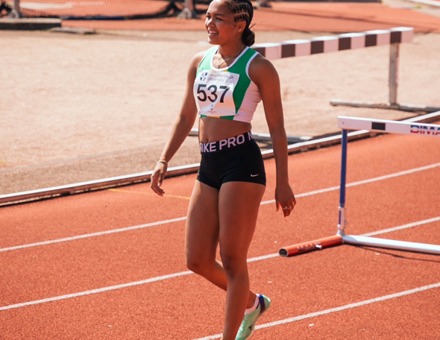
Amelia Briggs-Goode (ON 2020-22)
Amelia Briggs-Goode is the current School record holder for the Senior Girl’s 300m at 42.1s. and won the School Pentathlon Trophy in 2021. After leaving she has won Silver in the 400m Hurdles at the National Athletics Championships in July 2024 and was placed 4th in the UK as well as 4th in England overall.
Representing Great Britain and N.I. she is currently in trials for the British Championships and the Olympics while representing Birmingham University in Hurdles and Relay.
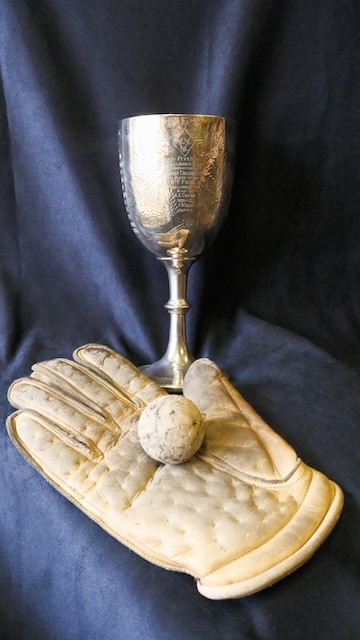 The Cullen Cup. A Fives Glove and Ball
The Cullen Cup. A Fives Glove and Ball
In the 1870s the Town Clerk, gentleman of the town Mr William Enfield died. Remembered with respect as a most intelligent and accomplished man and he was a good friend to Nottingham High School and on his death his friends collected over £600 to found a scholarship in his memory. It was decided that some of this money was to be used to erect a Fives Court in the north-east corner of the playground. The playground was unpaved and of loose rough sand and impossible to use for sport for most of the winter months. In June 1874, whilst awaiting the Charity Commission’s permission to use the money in this way, two Governors of the school and the ‘Clerk of the Works’ paid a visit to Rugby School in order to inspect the Fives Courts there. Fives was an ancient game akin to Handball or Squash that most of the wealthier Public Schools were playing. Rugby School had formalised its own Rules and it was determined that the High School use Rugby Rules and play Rugby Fives over the alternative, Eton Fives.
The first of the two Courts, which was named after Mr Enfield, was completed in 1875, together with the tall, forbidding wall on the Forest Road side of the playground which stands to this day. This Fives Court was built in a Gothic style, and was mistaken for a small chapel on numerous occasions. In the following year a second Court, this time an open one, was built.
A Fives Club was instituted consisting of 20 boys and 7 Masters and a prefect, A.V.Paton ,was voted in as Captain/Secretary/Treasurer. In 1879 the first public match consisted of Sixth Form versus Old Boys. The result was a gentlemanly draw.
There were rarely external fixtures, but the first mention of such was in the December 1927 School Magazine of a match vs. King Edward VII School, Sheffield, which the school won 6 games to 2. A witty report, written by two boys (Bowman and Walker), expressed the hope that a return fixture might be played in Sheffield. [The away match did take place and was a draw.]
The writers also championed the internal Fives competition for younger pupils, challenging the notion held by “certain members of the School” at that time that “Fives is a game for invalids”.
In later years, the magazine referenced the difficulty of finding gloves to play with and later a shortage of balls from 1944-48 was noted with sometimes as few as two balls available, a big problem in wet weather when lots of boys wanted to play. Fives was regarded as an “excellent game for the Christmas holidays when Rugger is unavailable”.
Balls became readily available again in the 1950s and these next 20 years turned out to be the heyday of Fives at the school. There is a long report in the March 1959 Nottinghamian magazine in which Kenneth Clarke, Captain of Fives and later to be Member of Parliament, Home Secretary and Chancellor of the Exchequer details results of 12 fixtures home and away, featuring matches for both 1st and a 2nd IV. This is the first time such detail is listed and scores are given in points. Matches home and away versus Buxton College and Queen Elizabeth GS, Mansfield [Eton Fives] were all lost. There were also fixtures planned vs. Sheffield University and the Old Nottinghamians and by 1970 there was a full programme of matches. However, a swift decline in the safety of the fabric of the Victorian courts led to them being closed and eventually demolished in 1989 to make way for the Sports Hall.
WWI. The Dead Man’s Penny
Cecil Dunbar Hutchinson was 11 when he came to the school in 1901. His father was a Printer and his mother a Milliner, making hats for the ladies of the town. In the early years of the century the family income grew allowing them to move from a small terraced house on Sneinton Dale to a large comfortable house on the Melton Road, West Bridgford and to send Cecil to the High School. Cecil was a drummer in the Cadet Corps by the age of 13 and a good footballer but never very academic, leaving school at 15 to join his father’s business as a letterpress printer in 1908.
Commissioned in the first year of the Great War into the 7th Battalion (service corps) of the South Staffordshire Regiment, Cecil sailed first to the Dardanelles to fight the Turkish Army in Gallipoli, then defended the Suez Canal for some time on the East Bank in Sinai, Egypt being under the control of the British Empire.
In 1916 his regiment was moved to France to work on the trenches around Thiepval and they sustained heavy losses. The following year, now a seasoned infantry officer, Cecil was recruited into the Royal Flying Corps and after basic training became an observer/gunner, the most hazardous of all positions. He was assigned to the 57th Squadron on 29 July 1917. Ten days later Hutchinson and his pilot took off from a French field for an evening photographic reconnaissance flight over the Belgium border and never returned. Mortally wounded by anti -aircraft fire, Cecil died a prisoner of war two days later in a German Field Hospital after his pilot was forced to crash- land the damaged plane. His pilot survived the war.
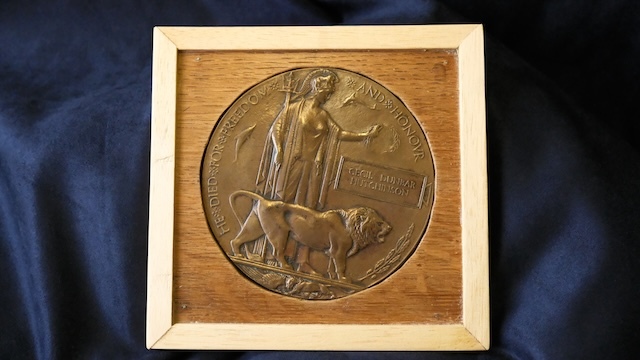 In February 1920, Cecil’s father Arthur Hutchinson received his son’s personal effects, a cigarette case, a pen-knife, a whistle and lanyard, a charm and his identity disc, via the German Government through diplomatic channels. Cecil Hutchinson died at the age of 25 years.
In February 1920, Cecil’s father Arthur Hutchinson received his son’s personal effects, a cigarette case, a pen-knife, a whistle and lanyard, a charm and his identity disc, via the German Government through diplomatic channels. Cecil Hutchinson died at the age of 25 years.
This personalised bronze Next of Kin Memorial Plaque, sometimes known as a Dead Man’s Penny, one of around a million sent out to bereaved families between 1919 and 1920 as a recognition of their loss, was donated to the school by Ray Parkinson and Bryan Palmer in 2009 who also researched the story. They found it in an antique shop in the 1980s.
WW2 Japanese POW Camp Old Nottinghamian’s Reunion Dinner. 1944
Geoffrey Machin North entered the school in 1918 and joined the school OTC in 1922. Good at drawing while at school he left to work for Boden &Co., Lace and Net Manufacturers, raising from clerk to Assistant Manager by the outbreak of World War Two. He was a regular member of the Forest Amateurs Cricket Club and played for the Notts 1st XV Rugby team. In 1939 he enlisted in the Army joining the Royal Artillery as a Gunner. He was posted to the Far East in 1941 but was captured by the Japanese in Java. Landing up at a POW Camp in Borneo, Geoff met Arnold Marchmont (previously Maschmeyer) a Captain in the R.A.O.C. who had left the High School 8 years before he had joined it. Geoffrey North became the Camp’s Head Gardener supplementing the appallingly meagre rations with fresh vegetables. On 3rd May , 5 years after the War had commenced and on Marchmont’s 5oth birthday, Geoff designed a dinner menu for possibly the most poignant ON’s Reunion Dinner.
Marchmont died the following May three months before Japanese surrender, but North survived the war and went on to set up two frozen food companies helping to launch the frozen food industry in post-war Britain.
Register of Nottingham High School. 1882-1897
Handwritten Registers have been kept since 1807, when the school resided on Stoney Street in the Lace Market. They are still handwritten today and are the first port of call for former pupils, their ch.
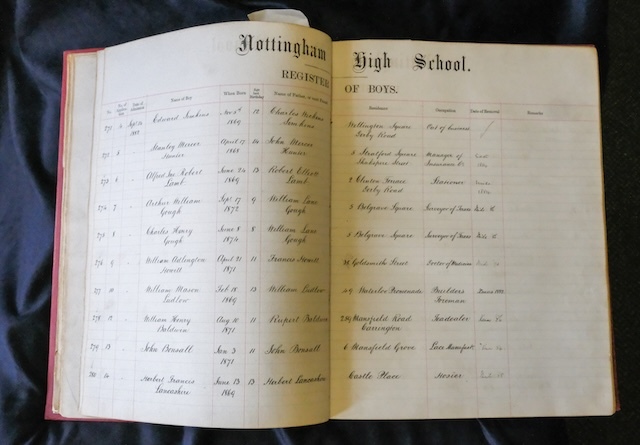
Sports Day Programme 1888.
Sport was very important at the Victorian school and several pupils of the 1870s and 80s later became prominent in Nottingham Cricket and Football, even representing England in the earliest years of Association Football and International Cricket. However, the school did not have a playing field until 1896 and it appears that an alternative high-profile venue, the Castle Ground, was booked in 1888 to carry out what appears to be the first Nottingham High School Athletic Sports Day.
Thoroughly reported in the local newspaper with all results and times, the heats included various distance Races, Throwing the Cricket Ball, A Master’s Race, 100 Yards Three-Legged Race, High Jump, Long Jump, Sack Race, One Mile Bicycle Race and a Tug of War.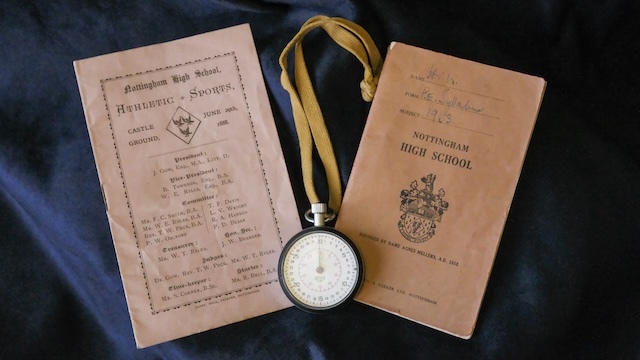
‘Chalky’ White’s PE Syllabus 1963
“4th Form. Term 1. Very vigorous first two lessons per term to ease the holiday flesh off”.
HV White affectionately known as Chalky was Rugby Coach and PE Master from 1957 - 1983. A distinguished Rugby player playing for Leicester and for captaining Cambourne, Chalky was the first professionally trained P.E. (Physical Education) Master to be employed by the school and he created a hugely successful and vibrant P.E. Department. He was known to introduce himself to new classes by walking out of his office on his hands. He was also Officer in Charge of the Royal Naval Section of the CCF. During the same period Chalky was Coach to Leicester Rugby Club and took the Tigers to John Player Cup wins in 1979, 1980 and 1981, being losing finalists in 1978 and 1983. He went on to be a major figure in English Rugby Union as Organiser for the South West Division for many years.
Elizabeth 1 Seal and Royal Licence. 1594
The School owns both a Tudor Royal Licence (we call it the Charter) with Henry VIII Seal and an Elizabethan Royal Licence and Seal, both currently stored safely at the Nottinghamshire Archives. Both allowed the Sixteenth Century school to hold assets of a certain value to employ a school master. The school was endowed in 1513 with donations from Dame Agnes Mellers, Aldermen of Nottingham and individual tradesmen, given in money, property and land. In 1594 the amount allowed to be held was doubled from 20 Marks (£13) to 40 Marks (£26)
Bespoke slippers with Edward Roberts’ winning design for the Platinum Jubilee of Elizabeth II in 2022.
The design by Edward Roberts (2012-20), of a purple and platinum-coloured logo was selected as the winning entry in a competition run jointly by the Royal Household and the V&A to represent the celebration of 70 years reign of the late Queen. Ed said it was a "pleasure" to see his creation on everything from buses to chocolate bars and even deckchairs.
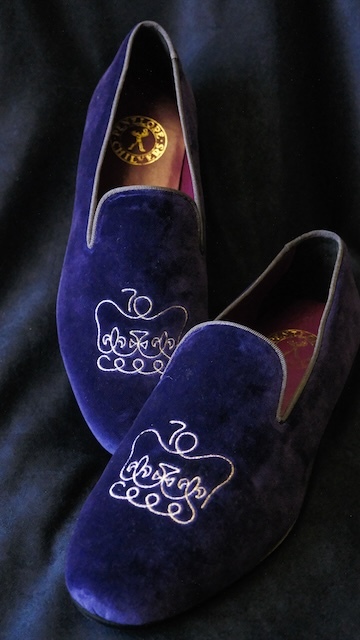
Punishment and Reward.
Gold, Silver and Bronze Medals awarded annually to deserving Sixth Formers 1888 to 1924.
Gold was for the Best Open Scholarship for University.
Silver was for the best pupils in Classics, Mathematics and Science.
Bronze was for Reading and Good Conduct. 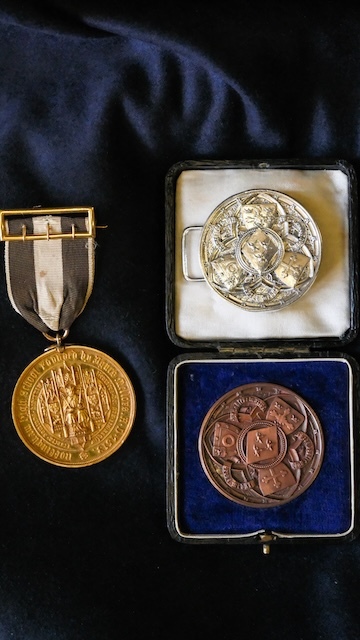
Prize Books awarded to deserving Senior School pupils.
Beautifully bound books signed by the Head Master were awarded mainly as (1st in) Form prizes, and occasionally for good Essays, Drawing or Singing. Many of these books return to us from the families of past pupils and it is hard to turn them down.
The Cane and Detention Book
The use of corporal punishment by cane, plimsoll, hand etc in Education used to be so acceptable it was taken for granted.
In 1872 Mr Irving, the 2nd Master was accused by several parents of striking their sons. On enquiry it was decided that in future no corporal punishment be inflicted by any master at the time of the event.
From 1880 to 1923 the official approach detailed in the High School Lists remained that the chief punishment is “detention” after school hours. However, “Boys who are too frequently detained or who commit offences for which detention is too mild a punishment, are liable to corporal punishment inflicted by the Head Master”.
In reality, however, naughty boys could choose to take their punishment from the Prefects and most did, because going before the Head Master was such a mortifying disgrace.
This practise came to an end in 1965 when the Prefects led by the School Captain and Vice-Captain, Tony Eltringham and Tony Palfreman requested an end to the onerous task of recording and undertaking the punishment and the Head Master KR Imeson agreed. A look at the detention books in the Archives shows the range of misdemeanours stay the same. Corporal Punishment now illegal.